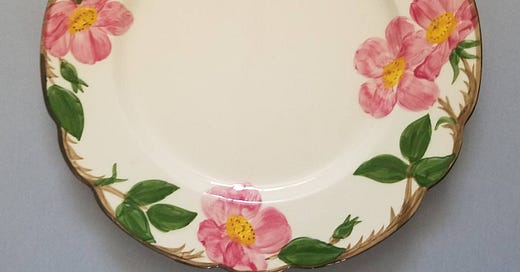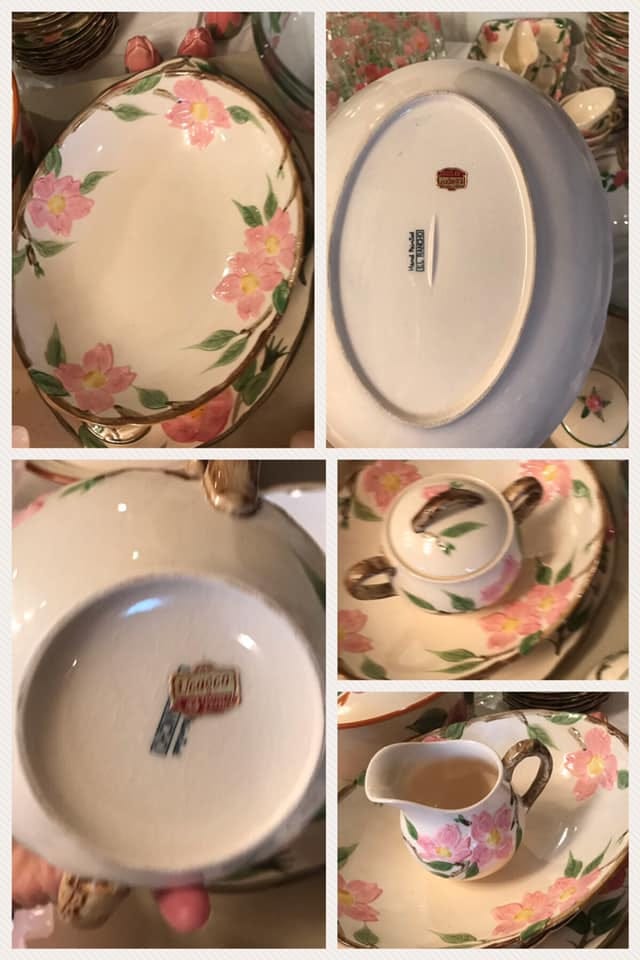Franciscan Desert Rose: Separating Myth from Masterpiece
Unraveling Myths and Misconceptions Surrounding America’s Most Beloved Dinnerware
Franciscan Desert Rose made its debut in 1941, quickly becoming one of the most recognizable dinnerware patterns in American history. Its delicate yet durable design was the result of a collaborative creative effort—Annette Honeywell’s artistic vision inspired the surface pattern, while Mary K. Grant, alongside her skilled design and engineering teams, shaped and styled the pieces that would define generations of dining tables.
Over the decades, Desert Rose has been the subject of much admiration—and, inevitably, a fair share of misconceptions. As its legacy spread, so did conflicting narratives about its origins and cultural significance. In this post, we dive into the internet’s most persistent myths and separate fact from fiction, ensuring that the true story of Franciscan Desert Rose remains as timeless as the pattern itself.
Website: Garrett On The Road
Fiction: “The Desert Rose pattern, the best-selling American dinnerware pattern in history, was designed by a Warner Brothers cartoonist.”
Fact: Annette Honeywell, the surface pattern designer for Franciscan Desert Rose was never a cartoonist for Warner Brothers. Annette Honeywell was an artist, and she designed compacts for Ernest Warner, doing business as Warner Productions Hollywood, Los Angeles, California for ‘empty ladies’ powder compacts made of base metals, leather, and plastics and adapted to contain face powder. The twelve designs by Honeywell, with her signature, were sold as “Originals by Warner of Hollywood.” There is no connection between Warner Productions Hollywood and Warner Brother’s movie studio.
Fiction: Before “Franciscan Ware” Desert Rose pattern dishes, there was El Rancho Desert Rose (or Wild Rose) dinnerware. These dishes, with the “Hand Painted El Rancho” stamp on each piece were manufactured from 1931 (when a patent was applied for) to 1938, possibly earlier according to some reports.” “Desert Rose would become one of the best known, most iconic, most copied tableware patterns in history. But it all started with the El Rancho line.”
Fact: A UCAGCO sticker was found on El Rancho. El Rancho (in the Wild Rose version and apple version) was made by UCAGCO in Japan and imported sometime between 1950 and 1962.
UCAGCO is the United China and Glass Company. Its offices were based in New Orleans and New York. Ucagco was primarily a distributor of dinnerware and glassware. They were the distributor of many Japanese china patterns during the early 1950s. United China & Glass Co. Inc., better known as UCAGCO, dating back to 1850. Founded by Abe Mayer and originally called Abe Mayer & Co., the importer did business throughout the Southeast U.S. as well as Central and South America. It wasn't until the 30s that the company took on the official trademark of UCAGCO and began expanding overseas. In fact, after the war, the company's agent in Japan, S.A. Stolaroff signed the very first contract allowing imports from Japan. A talented ceramic designer himself, Stolaroff worked alongside many Japanese potteries to lead the company's line of ceramics. In 1956, UCAGCO was sold to Sammons Enterprises and in 1962, Stolaroff, who had become the company's president, retired. (1)
Website: The Brooklyn Teacup
Fiction: “Franciscan’s pattern got a significant boost in popularity thanks to widescale advertising campaigns throughout the 1940s and 1950s that featured Hollywood celebrities such as Joan Crawford, Greer Garson, and Dorothy Lamour…. First Lady Jacqueline Kennedy chose Franciscan Desert Rose for use in the White House.”
Fact: Advertising campaigns throughout the 1940s and 1950s that featured Hollywood celebrities such as Joan Crawford, Greer Garson and Dorothy Lamour has never been documented. Jacqueline Kennedy may have had Desert Rose, however, use of Desert Rose in the private quarters of the Kennedy administration has never been documented. Jacqueline Kennedy’s mother-in-law, Rose Kennedy did order Franciscan Ivy for her Palm Beach, Florida home from 1962 through 1965.
In conclusion, the intriguing legacy of Franciscan Desert Rose is a tapestry woven with both documented history and enduring myths. Our journey through the contested narratives reveals that while popular tales—like the mistaken crediting of a Warner Brothers cartoonist or the assertion of an antecedent El Rancho dinnerware line—make captivating stories, the factual record tells a different story. Annette Honeywell’s artistic influence and the meticulous design work led by Mary K. Grant and her teams remain at the core of Desert Rose’s true origin, while the supposed connections to widely publicized celebrity endorsements and White House usage have not been substantiated by historical documentation.
By carefully sifting fact from fiction, collectors and enthusiasts not only safeguard the integrity of this beloved pattern but also deepen their appreciation for its genuine craftsmanship and cultural significance. The act of debunking myths reinforces the value of rigorous research and archival validation, ensuring that the true story behind every piece is celebrated alongside its enduring aesthetic appeal.
As our exploration of Franciscan Desert Rose comes to a close, it serves as a reminder that discerning authenticity in design is as much about preserving history as it is about celebrating art. Whether you’re a seasoned collector or a curious admirer, continuing to engage with reputable sources and expert communities will help illuminate the rich, nuanced journey of this iconic American dinnerware pattern.





